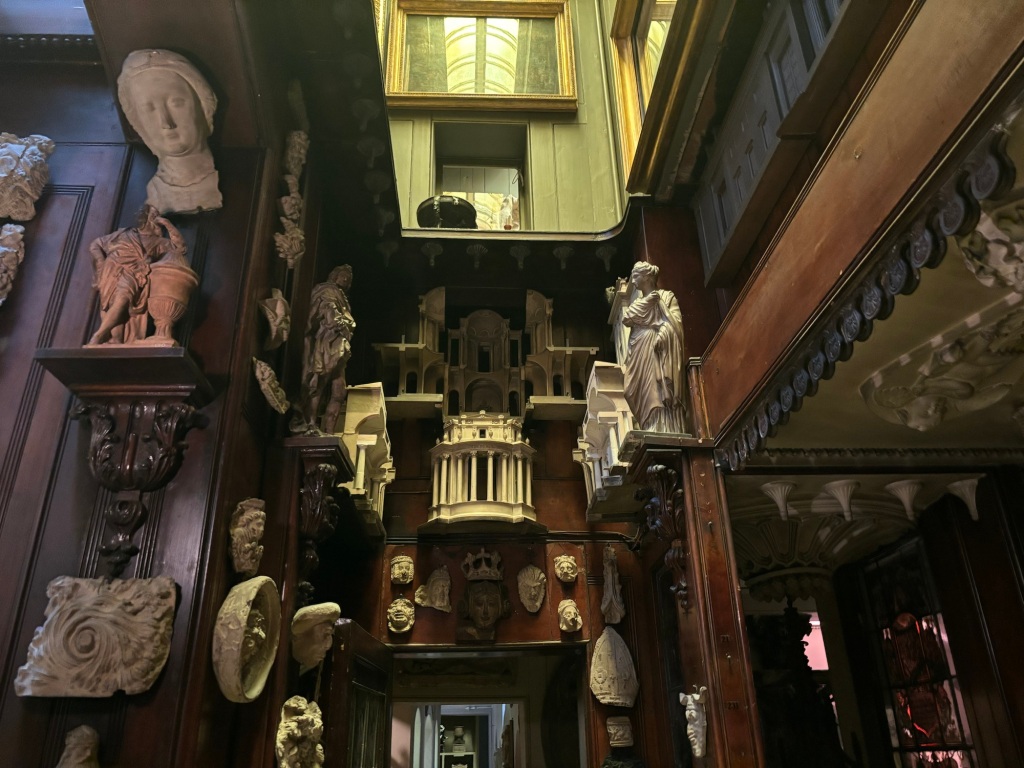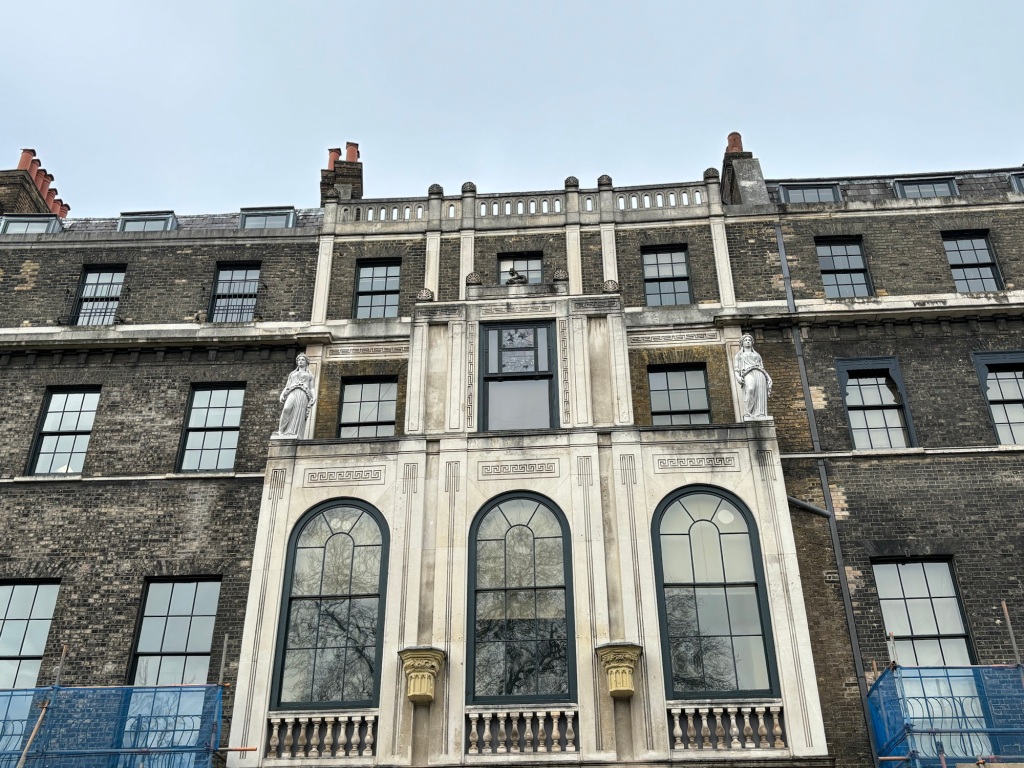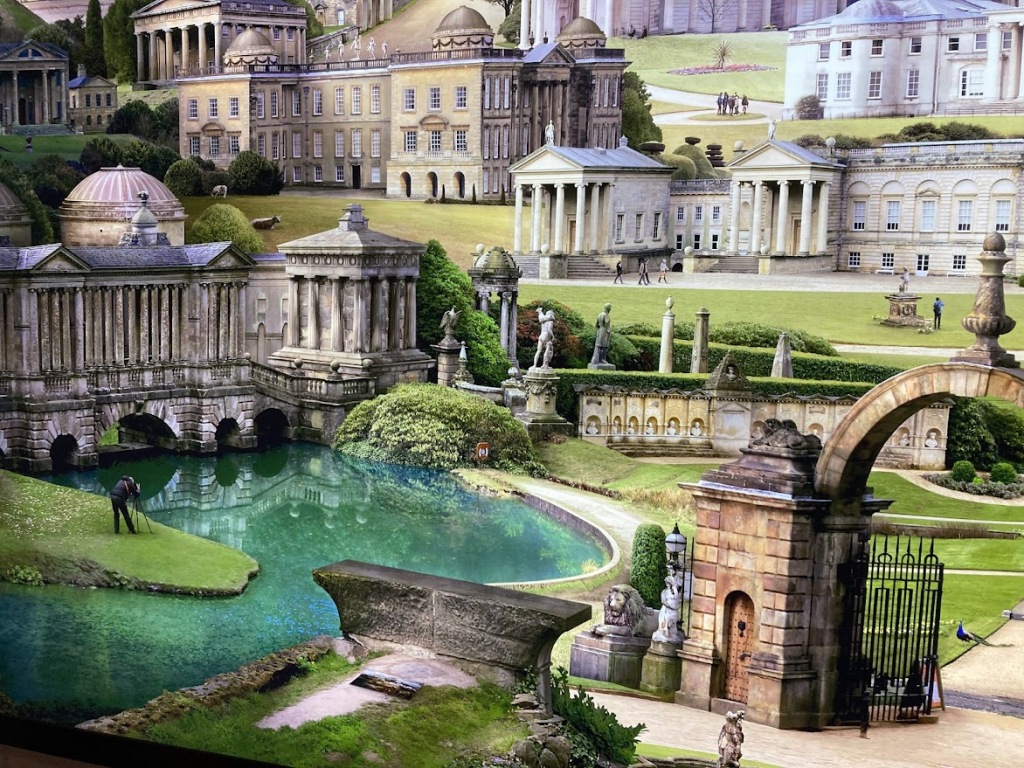




THE SOANE – Last week I had the good fortune to revisit The Soane Museum for the first time in a few years. The Soane is a charming and highly eclectic museum, made up of three private houses on the north side of Lincoln’s Inn Fields in Central London. The houses used to belong to John Soane, a famous architect of the 18th and early 19th century. Soane bought 12, Lincoln’s Inn in 1792. He knocked it down and rebuilt it as his home and office. Later he bought the two neighbouring houses. Soane was an avid, even obsessive collector, and in his latter years he arranged (by Act of Parliament) to leave his home and collection exactly as it was at the time of his death ‘in perpetuity’ to the nation. This forward-looking action of Soane’s meant that his home and private collection has remained intact and is available for us, now, to visit and discover, just as it was during Soane’s lifetime.
Soane died in 1837 and his house has been a museum, open to the public ever since. Now 187 years later visitors can wander through the Drawing Room and Morning Room of a gentleman’s 18th century property, stepping, quite literally, in the footsteps of the great man. The houses are filled with sculptures and models, paintings and portrait busts, medallions and frieze-fragments, there’s even an Egyptian sarcophagus, purchased at great expense, by Soane in 1824. He actually out-bid The British Museum for whom the price tag of £ 2000 was too expensive.


These two photos show the facade of Soane’s private home at 12, Lincoln’s Inn Fields, London. Numerous architectural details and features are included in a neo-classical composite style!
John Soane was the son of a bricklayer, from a modest, hard-working background. From an early age he was a gifted artist and accomplished draughtsman. At the age of just 23 (in 1776) he designed a ‘Triumphal Arch’ in an architectural competition run by the Royal Academy. He won the competition and was awarded a Gold Medal by the RA. He also won a travel scholarship to Italy.
SOANE’S GRAND TOUR – When John Soane embarked on his own ‘Grand Tour’ of Italy two years later the experience was to profoundly inform and influence his career and his later works. He travelled from England via Paris to Rome. In Paris he visited Versailles, generally regarded as the most splendid and majestic palace in Europe. He reached Rome in May, 1778. He then travelled extensively in Italy & Sicily for the next two years, returning to London in late 1780.
Soane visited and sketched numerous palaces, churches, public buildings and archaeological sites during his travels. He was particularly interested in the Temple of Vesta at Tivoli (just outside Rome) a circular Roman Temple dating from the 1st century BCE (or BC). He was also fascinated by Hadrian’s Villa also at Tivoli – and dating from around the 1st century AD. Shortly afterwards Soane was introduced to Frederick Hervey, Bishop of Derry and Earl of Bristol. This larger than life character presented Soane with a copy of ‘I Quattro Libri di Architecttura’ by Andrea Palladio. Palladio was probably the most influential architect of the period. ‘Discovered’ by Lord Burlington in the 17th century and introduced into the British Isles in the early years of the 18th century, the so-called Palladian style of symmetry, classical Roman architectural principles and numerous pillars and pilasters flanked with statues, revolutionised country house style and design from Chiswick (below) to North Yorkshire.



Palladio-inspired Chiswick House (London) left. Tivoli Corner (centre), Bank of England designed by John Soane. Inspiration came from Temple of Vesta at Tivoli (right) circular facade & Corinthian columns was sketched & admired by many.
A WORKING HOLIDAY – Soane’s ‘Grand Tour’ really was a working holiday for this young, aspiring architect. Everywhere he went he was producing detailed, measured drawings and ground plans of numerous buildings. He also began work on a design for a ‘British Senate House’ to be submitted to the Royal Academy’s exhibition of 1779. In addition he was meeting aristocratic British ‘grand tourists’ some of whom would become customers in the future. The Earl-Bishop of Derry ‘Lord Bristol’ introduced Soane to numerous well-heeled ‘milordi’ types. He also persuaded the young Soane to travel south with him to Naples, where he saw Vesuvius, visited Pompeii and explored Pozzuoli. In the 1770s Vesuvius was having an active phase and it was common for visitors to enjoy the nightly ‘light show’ spectacular from the terrace of William Hamilton’s grand abode in Naples. Hamilton was an antiquarian and also British Ambassador to the Kingdom of Naples. He is famous for two things – the so called ‘Hamilton Vase’ in the British Museum and his (more illustriously) beautiful and youthful wife Emma, who became Nelson’s lover just a few years later.
VOLCANOES – It’s true to say that Naples, with or without an erupting Vesuvius had a dramatic impact on the ‘grand tourists’. A vast, active volcano, sulphuric plumes of smoke at Campo Flegrei and two recently discovered towns ‘below ground’ emerging from a one and a half millenium snooze, created a heady mix of drama and excitement in 18th century Europe. Soane was able to visit Naples and the Palace of Caserta and also to see the recently excavated archaeological sites at Pompeii and Herculaneum. You can imagine that he was suitably impressed. It’s interesting to note that the study of archaeology, the examination of ancient artefacts to understand and explain the past, was developed around the Bay of Naples from about 1740 in the shadow of Vesuvius. Serious excavations began at Herculaneum in 1738, followed by Pompeii in 1748. Both towns were completely engulfed in volcanic material during the eruption of Vesuvius in AD 79. It wasn’t until centuries later that a local landlord, whilst building a well, or trying to (in 1709), that a shaft dug by the workers revealed Roman statues and a stage. The dig had accidentally unearthed the site of a Roman theatre – buried and forgotten for more than 1600 years.


Left – above: Temple of Isis, Pompeii – etching by Piranesi (1778) & hand-coloured by L J Desprez (1788). Cleveland Art Museum, USA. Above right – Temple of Isis, Pompeii (1776) – Artist Pietro Fabris (1740-1792) – Wellcome Foundation, London
PIRANESI – In 1778 John Soane met Giovanni Battista Piranesi in Rome. It was the year before Piranesi died. Piranesi had already sketched numerous ‘vedute’ views and was famous for his ‘Vedute di Roma’. Many of these meticulously executed sketches of the famous sites of Rome, including The Forum, Colosseum and Pyramid of Cestius were homework to the young British milordi being dispatched across Europe to acquire some culture and learning in Florence, Rome and Naples. Piranesi was very interested in the architecture of the ancient world and devoted his life to recording, as accurately as he could, the ruins, remains and structures of the Roman world. In 1777 Piranesi travelled to Paestum (a few hours south of Naples) to cast an eye over the spectacular Greek temples there. These sketches were bought by Soane in 1817 and became an integral part of his picture gallery, which included a trio of Canaletto paintings, fifteen Piranesi sketches and at least half a dozen Hogarth paintings depicting every day London life.


Sketch by Piranesi of Paestum (Greek Temples) c. Right water colour by Pietro Fabris, Paestum Temples
THE GRAND TOUR – it is no exaggeration to assert that John Soane’s Grand Tour to Italy in the 1770s changed the course of his life. He returned to London in 1780 fully versed in the principles of classical architecture. His trunks and suitcases were filled with sketches of every architectural feature imaginable; arch, portico, pediment, pillar, capital, medallion, and more………. add more here /
He returned to a London awash with Greek and Roman classical souvenirs. The Grand Tourists were returning from Europe in their droves, loaded down with sculptures and marbles, some genuine Roman marbles dating from the 1st and 2nd centuries. Others that were fakes. One of the most famous marble restorers in Rome was Bartolomeo Cavaceppi, who actually had a studio in the arches of the Colosseum. His workshop was a popular stop on the Grand Tour and he did a brisk trade in all types of sculpture; originals, restorations and even fakes. Back in London collectors like Charles Townley were only too keen to show their friends and associates their fabulous collections. The painting below (left) shows Charles Townley in his Sculpture Gallery at Park St, London in 1782. Just a few years later he sold most of his collection to the British Museum and many of his marbles can still be seen today in the Roman sculpture gallery at Great Russell St.


Charles Townley’s Sculpture Gallery (1782) by Johann Zoffany (left) and Pannini’s ‘Roma Antica’ c. 1754
When Soane returned to London various commissions did follow – although not immediately. The Lord-Bishop whom he’d met on the Grand Tour was particularly fickle. First he summoned Soane to Ickworth House in Sussex and then to his house in Northern Ireland – where he received the princely sum of £ 30 for his efforts (a paltry amount for months of work). Some of the houses and buildings Soane did work on are listed here:
- Aynhoe Park, Northamptonshire (1799–1804); remodelled the interior
- Bank of England, London (1788–1833)
- Wimpole Hall, Drawing room and interiors (1790)
- Dulwich Picture Gallery, London (1811–14)
- Holy Trinity Church, Marylebone (1826–27)
- Honing Hall, Norfolk
- Moggerhanger House, Bedfordshire (1809–11)
- Pell Wall Hall, Market Drayton, Shropshire (1822–28)
- Piercefield House, Monmouthshire, Wales (1785–83)
- Pitzhanger Manor, Ealing (1800–03)
Soane’s legacy today really focuses on his work at The Bank of England, where he was Architect and Surveyor from 1788 and The Dulwich Picture Gallery, which he designed and built from 1811. From 1806 Soane was also Professor of Architecture at the Royal Academy, which gave him, quite literally, a platform and an audience to share his ideas of top lighting, classical domes and restrained neo-classical facades. The Drawing Room at Wimpole Hall is a favourite of mine. The domed ceiling reminds me of The Pantheon in Rome and of course the top-lighting is characteristic of Soane and introduced by him into various public spaces, for example art galleries and public rooms at the Bank of England. When Soane bought himself a country house to the west of London, in Ealing, he redesigned the property using a cacophony of classical motifs. Medallions and sculpted plaques, twin columns surmounted with statues (Palladian style) and a large demi-lunette window (for light) above the front door – very Roman.


The Yellow Drawing Room at Wimpole Hall, designed by Soane (left). Then at right Pitzhanger Manor, Soane’s country retreat in Ealing. A veritable pastiche of classical iconography.
SOANE’S TRAVELS AND INSPIRATION – took him as far south as Sicily, where he visited Palermo and especially the curious Villa Palagonia, known as the Villa of the Monsters for its grotesque characters (dwarves) gracing the walls. This series of grotesques, created from 1749 by Francesco Ferdinando II Gravina, Prince of Palagonia, aroused the curiosity of the travellers of the Grand Tour during the 18th and 19th centuries. These admirers include John Soane, Goethe and Alexandre Dumas. Later these same gargoyle-like statues fascinated one of the founding members of the surrealist group of painters and thinkers André Breton. The villa also had (and still has) an extraordinary mirrored gallery which I visited, by complete coincidence last June. It’s curious to think that Soane visited this same villa in Palermo a mere 243 years before me.
AND THE BEAT GOES ON….. Last year the Royal Academy staged a small exhibition of work by a very innovative British artist called Emily Allchurch – imagine my surprise when a chance trip to the Royal Academy introduced me to this wonderfully creative thinker. Allchurch travelled the length and breadth of the British Isles taking photographs of neo-classical houses exhibiting the influence of Soane’s architecture. These composite images (below) were created by the artist using digital photography and lightbox art to create a new interpretation of some of Britain’s country houses. A new take on Soane’s neo-classical pastiche lives on in the 21st century.


Emily Allchurch – Grand Tour II homage to Soane after JM Gandy (engraver) 2017 www.emilyallchurch.com
Notes:
- Piranesi (1720-1778) – Giovanni Battista (or Giambattista) Piranesi also known simply as Piranesi was an Italian classical archaeologist, architect, and artist, famous for his ‘vedute’ of Rome and Paestum. He spent a lifetime meticulously sketching and painting classical architecture in Rome, Campania and latterly Paestum. Soane met him and respected him greatly.
- Louis Jean Desprez – (1743–1804) was a French artist who hand coloured some of Piranesi’s sketches.
- The Soane Museum in London was John Soane’s home and private museum. Left to the nation on his death, in perpetuity, it is a wonderful example of an eclectic early 19th century home.
- The Soane is a treasure trove of information and a cornucopia of ‘stuff’. Never miss an opportunity to pop in – it’s at 12, Lincoln’s Inn Fields, London. 10 minutes walk from Euston. The Soane
- Soane’s life long association with the Royal Academy, where he ended up as Professor of Architecture, both enriched and financed his studies in architecture. Winning a Gold Medal at the Royal Academy as a young man funded his own personal ‘Grand Tour’.
- Soane’s Grand Tour in brief: Paris – Rome – Tivoli – Caserta – Naples – Salerno – Paestum. Then south to Sicily – Palermo – Bagheria (Villa Palagonia) – Segesta – Trapani – Selinunte and most impressive of all……Agrigento (Greek temples). Then on to Malta – Valletta – Siracusa (Greek colony) – Catania – Etna – Taormina – Messina and north to Sorrento and home via Rome, Ancona, Rimini, Bologna, Parma, Accademia di Milano, Verona, Vicenza, The Brenta and Venice (Palladian villas) and then Firenze and Bologna north to The Alps – Splugen Pass – Zurich – Schaffhausen – Basel – London.
- A History of the Grand Tour – by Janet Simmonds (2017)
- Crossing the Alps – Grand Tourist style – by Janet Simmonds (2018)
And if you are wondering how travellers crossed The Alps in the 1780s, depending on the size of your wallet, here’s your answer…….Please note: The chairmen of Mont Cenis were regarded as the best, both the strongest and the most agile!


Left – Grand Tourist carried over The Alps in a basic sedan chair. 1755 – George Keate. At right – The sedan chair ensured that the occupant avoided contact with the ground outside – which could be dirty, slippery and potentially ruinous for one’s expensive gown! The red sedan chair (right) was designed for city based activities not crossing mountain passes.
18th March 2024


Hi, Janet; I have just finished reading your latest Blog on Soane & the Grand Tour; and what can I say? Fascinating, erudite, brilliant… I can say all of these things – and many more! – but I wouldn’t want to turn your head too far; so I will just leave it at those three adjectives and pass on my congratulations and thanks for a REALLY interesting and enlightening read. I will certainly hope to visit the Sloane on a future visit to London.
Reading the details and itinerary of John Soane’s Grand Tour left me breathless and exhausted. It also made me wonder how on earth – in an age with no cars, computers, trains, skis or iPhones – he managed to visit so many places in such a relatively short space of time. How did he manage to get from A to B, including the arduous journey over the Alps?
Then I remembered your fascinating Blog on “Crossing the Alps – Grand Tourist Style” and your kind offer to carry me over the Alps in a plush sedan chair – (I’m still waiting….!) – and enjoyed re-reading that, Blog, as well.
Keep it up, young Lady.
Many thanks again,
Luv
John
To choose a block. There! I’ve typed it as instructed. NOW what happens?!
LikeLiked by 1 person
Received and appreciated – thank you xxx
LikeLiked by 1 person